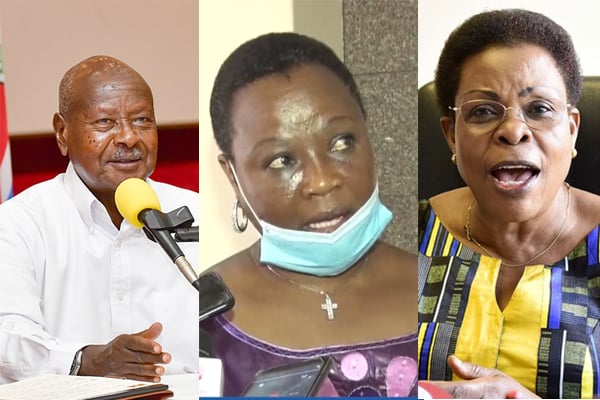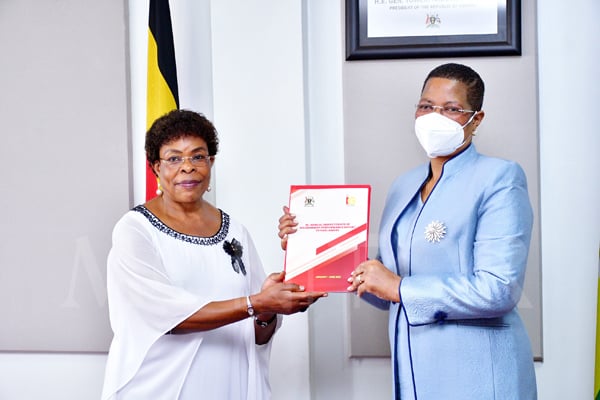Prime
Report: Shs1m lost to corruption each hour

Inspector General of Government Beti Kamya addresses journalists in Kampala on October 12. The Ombudsman says one of her challenges in fighting corruption is shortage of funds and staff PHOTO / FRANK BAGUMA
What you need to know:
- In an empirical study—the first of its kind—initiated by the Inspectorate of Government in 2021 to establish the cost of corruption in Uganda, it was discovered that 23 percent of the annual government budget is lost to the vice
Uganda loses at least Shs9.144 trillion to corruption conduits present in both the private and public institutions every year, the Inspectorate of Government has established.
Broken down to its constituent parts, the figure translates to an hourly loss of slightly above Shs1m or Shs25m each day.
In an empirical study—the first of its kind—initiated by the Inspectorate of Government in 2021 to establish the cost of corruption in Uganda, it was discovered that 23 percent of the annual government budget is lost to the vice. The study, which was bankrolled by the German government, used, among others, a “red flag” methodology to analyse public procurement spending.”
“Overall, the estimates on cost of corruption are considered to be lower than actual in Uganda since some costs are in kind, while others are non-measurable due to lack of data,” the report, whose data was collected from February to December 2021, states in part.
Speaker of Parliament Anita Among on Thursday expressed fears about the colossal amounts lost through corruption.
“This is really absurd because when we do appropriation of money and we are giving government money, the government [then] says there is no money yet money is siphoned out at a tune of Shs9.14 trillion,” Ms Among said, adding, “As IGG (Inspector General of Government), you still have a lot of work to do.”
Ombudsman Beti Kamya reckons that there is a need to “rebrand the war” against corruption by making it more people-centred, especially since the Inspectorate of Government is shorthanded.
“We are restricted by shortage of funds and staff because we have about 400 staff. The level of corruption is really high that the 400 people is just a drop in the ocean,” Ms Kamya said.
The report indicates that costs of corruption that impact everyone insofar as they are “not attributable to any specific group” amount to Shs339 billion per year. It adds that “savings from eliminating corruption in Uganda hold the potential to significantly improve the provision of public services to the citizens.”
The report’s datasets were collected, deducted and categorised in two broad forms—direct and indirect costs. The direct costs meant “cost to citizens who are required to pay a bribe to get a public service” while indirect costs meant those costs attributed to corruption but were hard to estimate in the course of the research.
Direct costs
Direct corruption costs were registered through salaries paid despite absenteeism, which is estimated at Shs2.3 trillion annually and loss of environmental resources bearing a corruption cost of Shs2.2 trillion each year.
Corruption in contract royalties tethered to natural resources such as oil (Shs858 billion), bribes dished out to judicial officers (Shs762 billion) and corruption in procurement processes (Shs614 billion) also stuck out like the metaphorical sore thumb as did bribery in the healthcare and education sectors.
“In total, the cost of corruption in healthcare amounts to nearly Shs191 billion per year and in the education sector, to about Shs278 billion per year,” the report revealed.
The other direct corruption costs were registered in security majorly in the course of bribing security personnel, with findings detailing that each Ugandan paid an average of Shs56,779. This works out to a grand total of Shs91 billion per year.
The processes of implementing regulation, as well as the procurement and budgeting also contribute to the direct costs of corruption in the country, as do user fees for public utilities.
“The level of bribery in water and electricity utilities, as well as the corruption costs of unpaid utility fees for the government contributes to a total loss of almost Shs478 billion,” the report reveals.
Indirect costs
The pick of the indirect costs are foreign direct investments net inflow losses totalling Shs18.5 billion, limited labour force supply that shears Shs320.5 billion in labour force participation rate, shelling out Shs763 billion on bribing judicial officers, as well as high interest rates that stop small and medium enterprises from submitting loan applications. Loss due to misreporting and underreporting of value-added tax by firms was estimated at Shs136 billion.
The findings of the empirical study are sure to carry a sense of loss and shock rolled in one. This is, especially so when viewed in the context of budgetary allocations to the different sectors and sub-sectors the study spotlighted.
For instance, the Shs726 billion reported to have been dolled out to Judiciary officials in bribes in 2019 eclipses the Shs393 billion ring-fenced for administration of justice in the budget for the Fiscal Year 2022/2023.
Similarly, the natural resources, environment and climate change budgetary allocation was Shs617 billion in the 2021/2022 budget. This is dwarfed by the Shs2.2 trillion that was lost to corruption in 2019 alone.
While the current budget shows that Shs1.231 trillion was committed towards the implementation of a “development plan” in the country, up to Shs2.3 trillion is lost to corruption in the form of salaries paid despite absenteeism.
Way forward
The ombudsman believes this inaugural study that interests itself in the granular details of corruption is of more utility than internationally commissioned surveys such as the Transparency International Corruption Index. Mr Kamya is not in doubt that the study shows corruption in Uganda is deep-seated. She, however, resists the temptation to describe it as endemic, instead making clear the need to change the mindset of Ugandans “so that people can adopt the ability to reject corruption.”
“The challenge is mainly in corruption because the population has accepted corruption as a way of life,” she told Sunday Monitor in an interview on Friday, adding, “People should know that they are entitled to good service. They should replace that way of accepting corruption with the sense of entitlement.”
Ms Kamya recommends that major focus be placed on strict implementation of laws, adding that this would close some major gaps exploited as conduits for corruption. The ombudsman’s office has currently placed strong concentration on settling matters out of court as such processes (plea bargains, etc.) save the government resources and time lost to long, drawn out litigations.
Ms Kamya revealed that her office commissioned the report since the government “needed a scientific baseline” on which to premise the programmes meant to tackle the vice of corruption in the country.
“We wanted to know which sector is most corrupt and where the money is mostly coming from and going,” Ms Kamya said, adding, “It has now given us a clear goal and we are saying next year, we want this figure to come down.”
About the report
The Government Transparency Institute (GTI) ran point on the empirical study that was carried out in 2021. A non-partisan think tank, GTI was founded in 2015 “to provide an independent, research-driven voice to the causes of transparency, anti-corruption and good governance.”
Mihály Fazekas, GTI’s founder and a PhD holder from University of Cambridge, was the lead researcher on this project, working in tandem with Isabelle Adam and Olena Nikulina.
The key objective of the study was “to generate empirical data on the cost of corruption in Uganda.” It achieved this by using a number of methodological approaches. Besides using a ‘red flag’ methodology, the research also benefited from reviews of relevant literature, secondary survey data, as well as qualitative methods such as interviews.
Background
Cost of corruption
Salaries paid despite absenteeism—Shs2.3 trillion
Loss of Environment resources—Shs2.2 trillion
Corruption in contract royalties—Shs859 billion
Bribing judicial officers—Shs762 billion
Corruption in procurement—Shs614 billion
What tackling corruption can save
Security—Shs4.2 trillion
Education—Shs3.4 trillion
Agriculture—Shs760 billion
Water and environment—Shs654 billion




